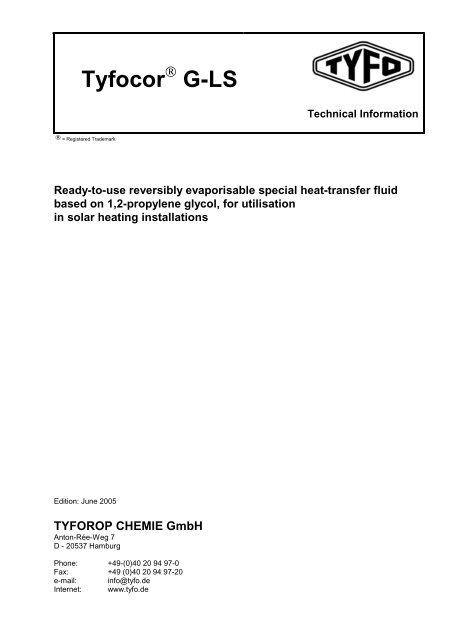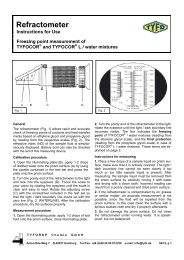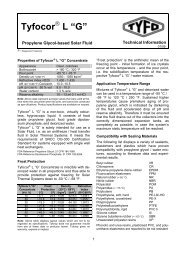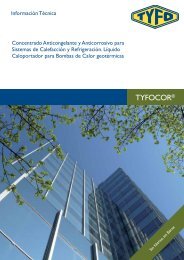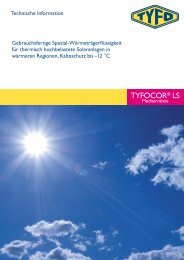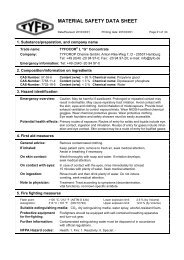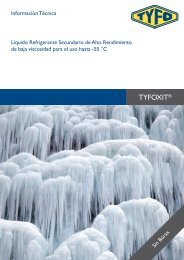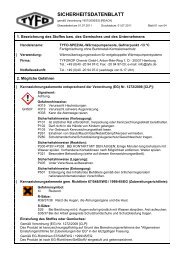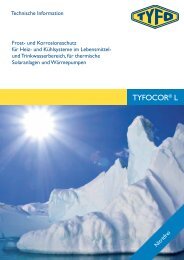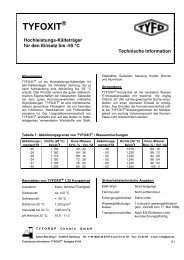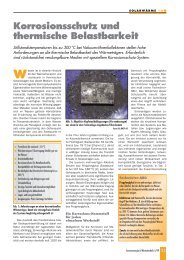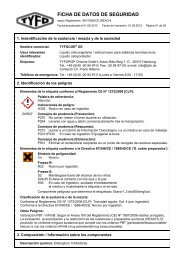Tyfocor G-LS - Tyforop Chemie GmbH
Tyfocor G-LS - Tyforop Chemie GmbH
Tyfocor G-LS - Tyforop Chemie GmbH
Create successful ePaper yourself
Turn your PDF publications into a flip-book with our unique Google optimized e-Paper software.
<strong>Tyfocor</strong> ® G-<strong>LS</strong><br />
Technical Information<br />
® = Registered Trademark<br />
Ready-to-use reversibly evaporisable special heat-transfer fluid<br />
based on 1,2-propylene glycol, for utilisation<br />
in solar heating installations<br />
Edition: June 2005<br />
TYFOROP CHEMIE <strong>GmbH</strong><br />
Anton-Rée-Weg 7<br />
D - 20537 Hamburg<br />
Phone: +49-(0)40 20 94 97-0<br />
Fax: +49 (0)40 20 94 97-20<br />
e-mail: info@tyfo.de<br />
Internet: www.tyfo.de
Chemical composition<br />
1,2-propylene glycol, water, and inhibitors<br />
Technical data Appearance clear, violet coloured liquid<br />
Density (20 °C) 1.032 – 1.035 g/cm³ ASTM D 1122<br />
Refraction index nD20 1.380 – 1.384 DIN 51 757<br />
pH value 9.0 – 10.5 ASTM D 1287<br />
Alkali reserve min. 20 ml 0.1 n HCl ASTM D 1121<br />
Viscosity (20 °C) 4.5 – 5.5 mm²/s DIN 51 562<br />
Boiling point 102 – 105 °C ASTM D 1120<br />
Flash point none DIN 51 376<br />
Water content 55 – 58 % DIN 51 777<br />
Frost protection –28 °C ASTM D 1177<br />
Quality control<br />
Properties<br />
Application<br />
Anticorrosion effect<br />
Compatibility with sealing<br />
materials<br />
The above data represent average values that were valid at the time<br />
when this Technical Information Bulletin went into print. They do not have<br />
the status of a product specification. Specified values are the subject of a<br />
special leaflet.<br />
<strong>Tyfocor</strong> G-<strong>LS</strong> is a clear, violet liquid with a faint odour, based on physiologically<br />
unobjectionable 1,2-propylene glycol, and water. It has been<br />
designed especially for utilisation as a heat transfer fluid in solar systems<br />
running under elevated thermal conditions (vacuum tube collectors).<br />
The corrosion inhibitors contained in <strong>Tyfocor</strong> G-<strong>LS</strong> reliably protect the<br />
materials normally used in solar installations against corrosion, ageing<br />
and deposits over long periods. <strong>Tyfocor</strong> G-<strong>LS</strong> prevents the surfaces of<br />
heat exchangers from becoming fouled, and ensures consistently high<br />
thermal efficiency of the solar system.<br />
In order to maintain its specific properties, <strong>Tyfocor</strong> G-<strong>LS</strong> must not<br />
be mixed with other heat transfer fluids, and must never be diluted<br />
by water. If leakages or other losses occur, the heat transfer fluid in<br />
the system must be replenished with <strong>Tyfocor</strong> G-<strong>LS</strong> only.<br />
<strong>Tyfocor</strong> G-<strong>LS</strong> is utilisable for solar systems with high stagnation temperatures,<br />
if following instructions are properly observed:<br />
It must be ensured that all of the heat-transfer fluid can drain out of the<br />
solar collectors into the - sufficiently dimensioned - expansion tanks when<br />
the maximum static temperature is reached, and thus the collec-tors<br />
remain completely empty.<br />
<strong>Tyfocor</strong> G-<strong>LS</strong> must not be exposed to sustained temperatures higher than<br />
170 °C. Temperatures higher than 200 °C lead to slow thermal decomposition<br />
of propylene glycol, which is indicated by darkening of the<br />
fluid. The lifetime of the medium may be strongly decreased in this case.<br />
<strong>Tyfocor</strong> G-<strong>LS</strong>‘s anticorrosive effect is evident from the following table:<br />
Corrosion test acc. ASTM D 1384 (American Society for Testing and Materials).<br />
Average weight change in g/m².<br />
___________________________________________________________<br />
Material<br />
<strong>Tyfocor</strong> G-<strong>LS</strong><br />
________________________________________________________________________________________________________________<br />
Copper (SF Cu) – 2.0<br />
Soft solder (L Sn 30) – 6.0<br />
Brass (MS 63) – 4.0<br />
Steel (HI) – 0.1<br />
Grey cast iron (GG 26) – 0.2<br />
Cast aluminium (G AlSi6Cu4) – 0.3<br />
<strong>Tyfocor</strong> G-<strong>LS</strong> does not attack the sealants normally used in solar<br />
systems. The following list of sealants, elastomers and plastics that are<br />
resistant to <strong>Tyfocor</strong> G-<strong>LS</strong> has been compiled from experimental results,<br />
experience, and the literature.<br />
2
Examples of sealants are Fermit ® and Fermitol ® (registered trademarks of<br />
Nissen & Volk <strong>GmbH</strong>, Hamburg), and hemp<br />
Butyl rubber<br />
IIR<br />
Chloroprene<br />
CR<br />
Ethylene-propylene-diene-rubber below 150 °C EPDM<br />
Fluorocarbon elastomers<br />
FPM<br />
Natural rubber below 80 °C<br />
NR<br />
Nitrile rubber<br />
NBR<br />
Polyacetal<br />
POM<br />
Polyamides below 115°C<br />
PA<br />
Polybutene<br />
PB<br />
Polyethylene, soft, hard<br />
PE-LD, PE-HD<br />
Polyethylene, crosslinked<br />
PE-X<br />
Polypropylene<br />
PP<br />
Polytetrafluoroethylene<br />
PTFE<br />
Polyvinylchloride, rigid<br />
PVC h<br />
Styrene butadiene rubber below 100 °C<br />
SBR<br />
Unsaturated polyester resins<br />
UP<br />
Phenolic and urea formaldehyde resins, plasticised PVC, and polyurethane<br />
elastomers are not resistant.<br />
An important point to note is that the performance of elastomers such as<br />
EPDM is determined by the nature and amount of the constituent additives<br />
and the vulcanisation conditions, as well as the properties of the rubber<br />
itself. For this reason, we would recommend testing the resistance of<br />
these elastomers to <strong>Tyfocor</strong> G-<strong>LS</strong> before they are put into service for the<br />
first time. This applies particularly to elastomers intended as mem-branes<br />
for expansion tanks as described in DIN 4807.<br />
Gaskets that have proved to be resistant to hot <strong>Tyfocor</strong> G-<strong>LS</strong> are: up<br />
to 160 °C: elastomer gaskets made from 70 EPDM 281*, and up to 200<br />
°C: flat gaskets such as REINZ-AFM 34** or Centellen 3820***, basing on<br />
aramide / special-NBR.<br />
Application guidelines<br />
In view of the specific properties of <strong>Tyfocor</strong> G-<strong>LS</strong>, the following instructions<br />
must be adhered to for ensuring long-term protection.<br />
1. Solar heating equipment must be designed as closed circuits, because<br />
entry of atmospheric oxygen leads to premature ageing and<br />
consequently reduces the life-span of the heat-transfer fluid.<br />
2. Flexible-membrane expansion tanks must conform to DIN 4807.<br />
3. Silver or copper brazing solders are to be utilised preferably on joints.<br />
Fluxes used in combination with soft solder usually contain chlorides.<br />
Their residues must be removed by thorough flushing of the system,<br />
because otherwise increased chloride concentration in the heattransfer<br />
fluid may lead to corrosion.<br />
4. The only flexible connections that are permissible are hoses, preferably<br />
metal, that do not permit the diffusion of oxygen.<br />
5. Equipment must not be fitted with galvanised heat exchangers, heat<br />
reservoirs, tanks, or pipes, because zinc is detached by 1,2-propylene<br />
glycol.<br />
6. Chemically speaking, <strong>Tyfocor</strong> G-<strong>LS</strong> is largely inert, but it is impor-tant<br />
to ensure that the manufacturer’s recommendations state that all the<br />
seals and connectors used in solar heating equipment are resistant<br />
up to the maximum temperature of the medium.<br />
7. Scaling on copper or copper alloys must be removed, because it can<br />
be detached by hot propylene glycol / water mixtures.<br />
* Carl Freudenberg, Dichtungs- u. Schwingungstechnik, Pf 100363, D-69465 Weinheim<br />
** REINZ-Dichtungs <strong>GmbH</strong>, Postfach 1909, D-89229 Neu-Ulm<br />
*** Hecker Werke <strong>GmbH</strong> & Co, D-71093 Weil im Schönbuch<br />
3
8. It must be ensured that no external voltages are applied between<br />
parts of the equipment that come into contact with <strong>Tyfocor</strong> G-<strong>LS</strong>, as<br />
otherwise corrosion may occur.<br />
9. The layout of the tubes must ensure that circulation cannot be disturbed<br />
by gas pockets or deposits.<br />
10. The level of the heat-transfer fluid must never be allowed to fall<br />
below the highest point in the system.<br />
11. It must be ensured that no air pockets remain in the installation after<br />
it has been filled.<br />
12. Dirt and water must not be allowed to enter the installation or its<br />
components during assembly and before filling. After assembly has<br />
been completed, the system must be flushed to remove any foreign<br />
matter (swarf, scale, packaging residues, sawdust, etc.) and material<br />
used in assembly.<br />
13. In order to ensure that there are no obstructions to the flow of the<br />
heat-transfer fluid, the in-circuit filters must be cleaned within 14<br />
days, at the latest, after the system has been filled with the medium<br />
and put into operation for the first time.<br />
14. If losses occur due to leakage or take-out, the heat-transfer fluid in<br />
the system must be replenished with <strong>Tyfocor</strong> G-<strong>LS</strong> only. Do not top<br />
up with water!<br />
Packaging<br />
Safety<br />
Safety Data Sheet<br />
Handling<br />
Ecology<br />
1.080<br />
<strong>Tyfocor</strong> G-<strong>LS</strong> is supplied in 10 l, 20 l, and 30 l non-returnable plastic cans,<br />
in 200 l non-returnable drums, and in road-tankers.<br />
<strong>Tyfocor</strong> G-<strong>LS</strong> contains 1,2-propylene glycol and is not subject to label-ling<br />
according to the regulations of the European Union.<br />
A Safety Data Sheet has been compiled for <strong>Tyfocor</strong> G-<strong>LS</strong> in accordance<br />
with EEC Directives 91/155/EEC and 2001/58/EEC, resp.<br />
The usual safety and industrial hygiene measures relating to chemicals<br />
and flammable liquids, and the information and instructions given in our<br />
Safety Data Sheet must be observed in handling <strong>Tyfocor</strong> G-<strong>LS</strong>.<br />
<strong>Tyfocor</strong> G-<strong>LS</strong> is classified in water hazard class 1 (low-rate endanger-ing,<br />
Germany), acc. Annex 4, VwVwS of 17 May 1999. It is readily biodegradable.<br />
It does not impair the efficiency of the activated sludge if it is<br />
run with appropriate care into an acclimated effluent treatment plant.<br />
Density Dichte of von <strong>Tyfocor</strong> ® G-<strong>LS</strong> [g/cm 3 ]<br />
1.060<br />
1.040<br />
Dichte [ kg/m³ ]<br />
1.020<br />
1.000<br />
980<br />
4<br />
960<br />
-30 -20 -10 ± 0 10 20 30 40 50 60 70 80 90 100 110 120<br />
Temperature [ [°C] ]<br />
4
Viskosität von <strong>Tyfocor</strong> <strong>LS</strong><br />
Kinematic Viscosity of <strong>Tyfocor</strong> ® G-<strong>LS</strong> [mm 2 /s]<br />
500<br />
200<br />
100<br />
Viskosität [ mm²/s ]<br />
50<br />
20<br />
10<br />
5<br />
2<br />
1<br />
-30 -20 -10 0 10 20 30 40 50 60 70 80 90 100 110 120<br />
Temperature [[°C]<br />
]<br />
4,1<br />
Spezifische Specific Heat Wärmekapazität Capacity of <strong>Tyfocor</strong> von ® G-<strong>LS</strong> <strong>Tyfocor</strong> [kJ/kg·K] <strong>LS</strong><br />
4<br />
Spez. Wärmekapazität [ kj/kg*K ]<br />
3,9<br />
3,8<br />
3,7<br />
3,6<br />
3,5<br />
3,4<br />
3,3<br />
-30 -20 -10 ± 0 10 20 30 40 50 60 70 80 90 100 110 120<br />
Temperatur [ °C ]<br />
Temperature [°C]<br />
5
0,5<br />
Wärmeleitfähigkeit von <strong>Tyfocor</strong> <strong>LS</strong><br />
Thermal Conductivity of <strong>Tyfocor</strong> ® G-<strong>LS</strong> [W/m·K]<br />
0,48<br />
Wärmeleitfähigkeit [ W/m*K ]<br />
0,46<br />
0,44<br />
0,42<br />
0,4<br />
0,38<br />
0,36<br />
-30 -20 -10 ± 0 10 20 30 40 50 60 70 80 90 100 110 120<br />
Temperature [[°C]<br />
]<br />
20<br />
15<br />
10<br />
Dampfdruck von <strong>Tyfocor</strong> <strong>LS</strong><br />
Vapour Pressure of <strong>Tyfocor</strong> ® G-<strong>LS</strong> [bar]<br />
5<br />
Dampfdruck [ bar ]<br />
1<br />
0,5<br />
0,1<br />
40 50 60 70 80 90 100 110 120 130 140 150 160 170 180 190 200<br />
Temperatur [ °C ]<br />
Temperature [°C]<br />
6
90<br />
Kubischer Cubic Expansion Ausdehnungskoeffizient Coefficient of <strong>Tyfocor</strong> von ® G-<strong>LS</strong> <strong>Tyfocor</strong> [x10 - 5/K] <strong>LS</strong><br />
Kubischer Ausdehnungskoeffizient [ *10 ^-5 /K ]<br />
80<br />
70<br />
60<br />
50<br />
40<br />
30<br />
-30 -20 -10 ± 0 10 20 30 40 50 60 70 80 90 100 110 120<br />
Temperatur<br />
Temperature<br />
[ °C<br />
[°C]<br />
]<br />
Note<br />
The information submitted in this publication is based on our current<br />
knowledge and experience. In view of the many factors that may affect<br />
processing and application these data do not relieve processors<br />
of the responsibility of carrying out their own tests and experiments,<br />
neither do they imply any legally binding assurance of certain properties<br />
or of suitability for a specific purpose. It is the responsibility of<br />
those to whom we supply our products to ensure that any proprietary<br />
rights and existing laws and legislations are observed.<br />
TYFOROP CHEMIE <strong>GmbH</strong><br />
Anton-Rée-Weg 7<br />
D – 20537 Hamburg<br />
Phone: +49-(0)40 20 94 97-0<br />
Fax: +49-(0)40 20 94 97-20<br />
e-mail: info@tyfo.de<br />
Internet: www.tyfo.de<br />
7


